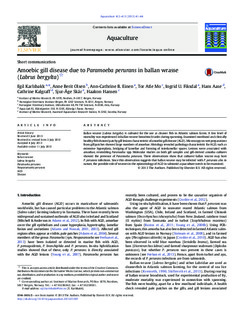Amoebic gill disease due to Paramoeba perurans in ballan wrasse (Labrus bergylta)
Karlsbakk, Egil; Olsen, Anne Berit; Einen, Ann-Cathrine B.; Mo, Tor Atle; Fiksdal, Ingrid U.; Aase, Hans; Kalgraff, Cathrine; Skår, Sjur-Åge; Hansen, Haakon
Journal article, Peer reviewed
Date
2013-07-11Metadata
Show full item recordCollections
- Articles [3009]
Original version
Karlsbakk, E., Olsen, A.B., Einen, A.-C.B., Mo, T.A., Fiksdal, I.U., Aase, H., Kalgraff, C., Skår, S.-Å., Hansen, H., 2013. Amoebic gill disease due to Paramoeba perurans in ballan wrasse (Labrus bergylta). Aquaculture. 412–413, 41-44. 10.1016/j.aquaculture.2013.07.007Abstract
Ballan wrasse (Labrus bergylta) is cultured for the use as cleaner fish in Atlantic salmon farms. A low level of mortality was experienced in ballan wrasse broodstock tanks during spawning. Examined moribund and clinically healthy fish showed patchy gill lesions characteristic of amoebic gill disease (AGD). Microscopy on wet preparations from gill patches showed large numbers of amoebae. Histology revealed pathology characteristic for AGD, such as extensive hyperplasia, bridging of lamellae and forming of interlamellar spaces. Lesions were associated with amoebae, resembling Paramoeba spp. Molecular studies on both gill samples and gill-derived amoeba-cultures showed the presence of Paramoeba perurans. These observations show that cultured ballan wrasse may host P. perurans infections. Since this observation suggests that ballan wrasse may be infected with P. perurans also in nature, the possible role of wrasses in the epizootiology of AGD in salmonid aquaculture needs to be examined.
